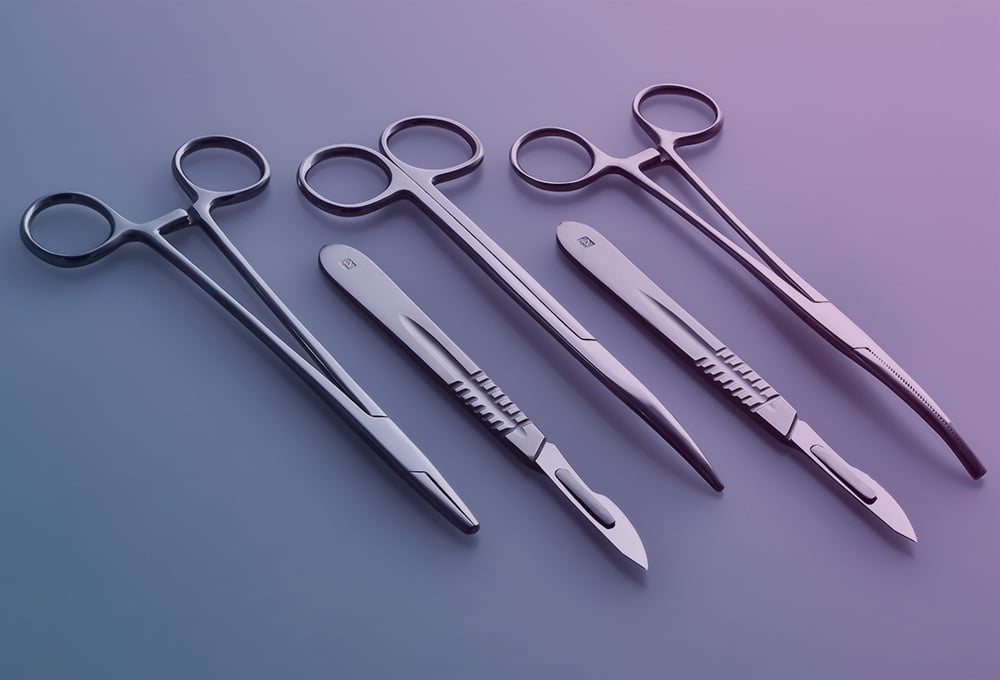Surgical instrument inventories vary widely, which is why it’s important to have versatile options for surgical instrument identification and labeling. While marking surgical instruments might sound tedious, it doesn’t have to be.
Surgical instrument identification methods
Thanks to new technologies in the sterile processing industry, labeling and tracking surgical instruments and trays is easier than ever. Surgical instrument identification solutions can house all instrument labeling techniques in one place, offering you complete control of your inventory and eliminating the need for multiple vendors.
To help you better understand what surgical instrument identification techniques might work best for your facility, we’ve compiled a list of a few options and their associated pros and cons.
What are the Current Surgical Instrument Identification Methods?
Because each healthcare facility has different needs, there is no one-size-fits-all solution when it comes to surgical instrument identification and marking techniques. The best methods for your organization will depend on your overall inventory and the material, size and shape of each instrument.
Electrochemical marking
The electrochemical (ECM) surgical instrument marking method uses an electrical current, stencil and electrolyte fluid to place a mark on stainless steel instruments. Unlike etching and engraving, this mark doesn’t alter the surface of the instrument because it is applied below the instrument’s protective passivation layer.
Pro: Electrochemical marking creates a corrosion-free mark that doesn’t compromise the surgical instrument’s integrity.
Con: The marks can erode over time and can sometimes be inadvertently removed if the instrument needs to be buffed during maintenance or repair.
Laser marking
Laser marking is the process of creating a traceable 2D barcode on a surgical instrument by heating its surface with a laser. It’s important to note that laser marking is NOT the same as laser etching or engraving, which creates grooves that impact the instrument’s surface. This not only compromises the integrity of an instrument – it also poses a threat to patient safety by creating a hiding space for bacteria and debris.
Pro: Lasers can place marks on a wider variety of instruments, such as ones with smaller shafts or less open space.
Con: Laser marks may erode over time and, like electrochemical marks, can be removed by buffing during maintenance or repair.
Marking tape or dots (mechanical)
Depending on your inventory, you may manage surgical instruments that aren’t suited for a laser or ECM mark due to their material, shape or size. Marking tape or dots can come in handy in these situations and are safe for sterilization.
Pro: Tape and dots are a cheap and easy way to mark instruments that can’t be marked with other methods.
Con: These marks don’t last as long as surgical instrument marking techniques such as a laser or ECM.
Benefits of Labeling Surgical Instruments vs. Trays
If you’re considering implementing a new surgical instrument identification solution, you’ll also need to decide whether to track trays or individual instruments. While tray-level tracking provides visibility into set usage, it lacks the detail and accountability of instrument-level tracking.
Though labeling individual instruments may require a greater initial investment, the long-term benefits outweigh the costs. Here’s a breakdown of the key differences:
Tray labeling solutions
- Only requires trays to be labeled, therefore only trays can be tracked
- Any instrument can be matched to any tray
- Easier to adopt for first-time labelers and trackers
- Unable to provide historical data on where individual instruments were used
- Can track a tray back to a patient but not the instruments that were used
- Pose a liability threat for facilities if a patient is compromised by an instrument that is untraceable
- Unable to track down missing instruments when they are separated from their trays
Surgical instrument-level labeling solutions
- Provide complete visibility into where every instrument in a facility’s inventory has ever been used, improving workflow efficiency and patient safety
- Make it easier to identify which asset is at fault if an outbreak or infection occurs
- Make it easier to quickly locate specialized instruments for a particular case
- Identify allowable substitutions for instruments that aren’t available
- Provide real-time data to inform maintenance schedules
- Make it easier to find instruments involved in a recall
- Can present a learning curve for technicians
- Often requires a larger financial investment
Key Benefits of Surgical Instrument Identification
- Improves Patient Safety and Traceability
By labeling individual surgical instruments, facilities gain complete visibility into each instrument’s history, ensuring accountability during procedures and simplifying the response to recalls or infections. - Enhances Workflow Efficiency and Inventory Management
Accurate instrument identification helps technicians quickly locate the right tools, reduces delays in the OR, and ensures complete trays—minimizing downtime and avoiding surgical case disruptions. - Supports Regulatory Compliance and Maintenance
Instrument-level identification enables better documentation, tracking for sterilization cycles, and proactive maintenance—helping facilities meet compliance standards and extend instrument lifespan.
Trust Your Surgical Instrument Identification to CensiMark
CensiMark is a surgical instrument identification solution offering laser, electrochemical, and mechanical marking options. With CensiMark, you receive marking services, training and commissioning of the instruments into your system. The service is also scalable so you can mark instruments at your own pace.
To further increase its strength, efficiency and accountability, CensiMark can be paired with CensiTrac, the industry’s most capable and comprehensive surgical instrument tracking system that can be built to implement directly into your facility’s existing ecosystem. This software combination can alert technicians when a tray is incomplete or has the wrong instrument added to it, ensuring that trays are assembled correctly and in the right order to avoid delays in the operating room.
Learn more about CensiMark, CensiTrac and Censis’s other solutions here.


